
Magento Email Settings: 9 Steps to Configure SMTP Settings
Are your store emails reaching the right customers' inboxes? Magento Email Settings ensure smooth mail communication for your store. If you configure these settings correctly, your emails will reach customers reliably.
This tutorial will cover how SMTP mail settings help you improve your workflow.
Key Takeaways
-
What are the aspects of Magento email settings?
-
Customizable layouts and secure delivery are a few of its key features.
-
9 steps to set up SMTP settings in Magento 2.
-
The best 2 SMTP extensions improve email performance.
-
Practical tips ensure smooth mail delivery and better performance.
-
Common email issues in Adobe are easy to fix with clear solutions.
What are Magento Email Settings?
Magento Email Settings are used to ensure effective communication. It is between your ecommerce store and customers.
Magento Email Settings control how your store sends emails. These include order confirmations, shipping updates, and other notifications. Proper setup ensures smooth mail delivery and reliable email functionality for your store. The settings manage save contacts, sales email, and sender email details. Configuring SMTP setup allows your store to handle mailing.
Magento supports customized layouts for various communication needs. Testing with a trial email confirms everything is set up correctly.
Key Features of Magento Email Settings
1. Store Mail Addresses Configuration
Magento lets you set up multiple saved email contacts for different tasks. It ensures emails are sent from the correct address and look professional.
-
Sales Email Setup: Used for order confirmations, invoices, and shipping updates. Customers receive these emails for clear and reliable communication about purchases.
-
General Contact Email: Handles general inquiries as a central contact point.
-
Email Sender: Assign clear names and addresses to emails. It helps to improve branding and clarity.
Having specific names and email contacts for different tasks helps you manage communication. It helps to present a professional image.
2. SMTP Integration for Reliable Mailing
SMTP (Simple Mail Transfer Protocol) improves email deliverability and helps ensure its secure and reliable delivery.
-
Connect your store to an SMTP host or use an SMTP provider. It includes SendGrid or Mailgun to send mail securely.
-
It helps ensure important emails. This includes order confirmation emails, shipping updates, and account notifications. It helps to reach customers instead of getting flagged as spam.
-
Magento supports SMTP configuration and improves e-messaging.
A custom SMTP host prevents delivery issues. It helps to ensure emails reach the right inbox.
3. Customizable Mail Layouts
Magento allows you to customize your email setup. It makes aligning email designs with your brand easy.
-
Order Confirmation Email: When customers place orders, these can include personalized details.
-
Shipping Notifications: Keep customers informed about the shipping status of their orders.
-
Customer Account Updates: Send branded messages for updates. It includes password resets or account changes.
Customizing layouts with your logo, colors, and text. It helps to ensure your emails reflect the store’s style and build customer trust.
4. Email Testing and Logs
Magento provides tools to test and monitor your email processes. It helps to ensure they work as expected.
-
Test Your Email: It helps you check if emails are being sent and received correctly. This lets you find and fix issues early.
-
Emails Sent from Magento: It tracks all outgoing emails. This lets you monitor delivery and troubleshoot Magento errors.
Testing and tracking your emails ensures a smooth customer experience and reliable communication.
5. Multiple Store Views Support
Magento supports multiple store views. It lets you set up a unique email setup for each store view.
-
The feature is helpful for stores that serve different regions or languages.
-
Each Magento 2 store's email configuration can include tailored mail-sending settings and layouts.
For example, you can send mail in English to the US and French for European customers. It helps to create a personalized and localized experience.
6. Advanced Mail Sending Settings
Magento gives you advanced options. They are used for managing mail-sending settings, offering flexibility for handling emails.
-
Set Up SMTP: Configure a dedicated SMTP mail server. It is secure and efficient mail delivery.
-
Batch Processing: Manage bulk emails like newsletters to avoid overloading your server.
-
General Settings: Adjust settings like SMTP parameters and batch sizes for better performance.
These features let you fine-tune mailing to match your store’s needs. It helps to optimize the performance of the ecommerce store.
7. Enhanced Security Features
Magento prioritizes secure e-messaging with built-in security protocols.
-
SPF (Sender Policy Framework): Only authorized servers can send an email.
-
DKIM (DomainKeys Identified Mail): Adds a signature to verify your legitimate emails.
-
DMARC (Domain-based Message Authentication, Reporting, and Conformance): Prevents phishing and spoofing attacks.
These features reduce the chances of your emails being flagged as spam. It helps to protect your customers from fraud.
8. Integration with Third-Party Tools
Magento supports integrations with external tools to enhance your email functionality.
-
SMTP Plugins: Add features like email tracking and analytics using third-party SMTP services.
-
Marketing Platforms: Sync Magento with tools like HubSpot. It helps to automate promotional campaigns and follow-ups.
These integrations make your email interactions more efficient and valuable.
9. Optimized Deliverability of Email
Magento is designed to ensure mail deliverability. It helps your emails avoid spam folders and reach the right audience.
-
SMTP Configuration: Proper setup ensures secure delivery of emails.
-
Compatibility with most email hosting services guarantees smooth performance.
-
Batch processing and logs let you track and optimize your email setup for the best results.
Reliable delivery ensures your communication efforts are not wasted. They help to build trust with your customers.
9 Steps to Configure SMTP Email Settings in Magento 2
Step 1: Enable SMTP Settings
-
Go to Stores > Configuration > Extension Name > SMTP Configuration.
-
Enable the SMTP email settings to begin the setup.
Step 2: Specify the Local Client Name
Enter the Local Client Name. It can be your domain name or the IP address of your Magento 2 store.
Step 3: Select an Authentication Method
Choose an Authentication Method that matches your email client or server:
-
LOGIN
-
PLAIN
-
CRAM-MD5
-
NONE
Step 4: Choose an SSL Type
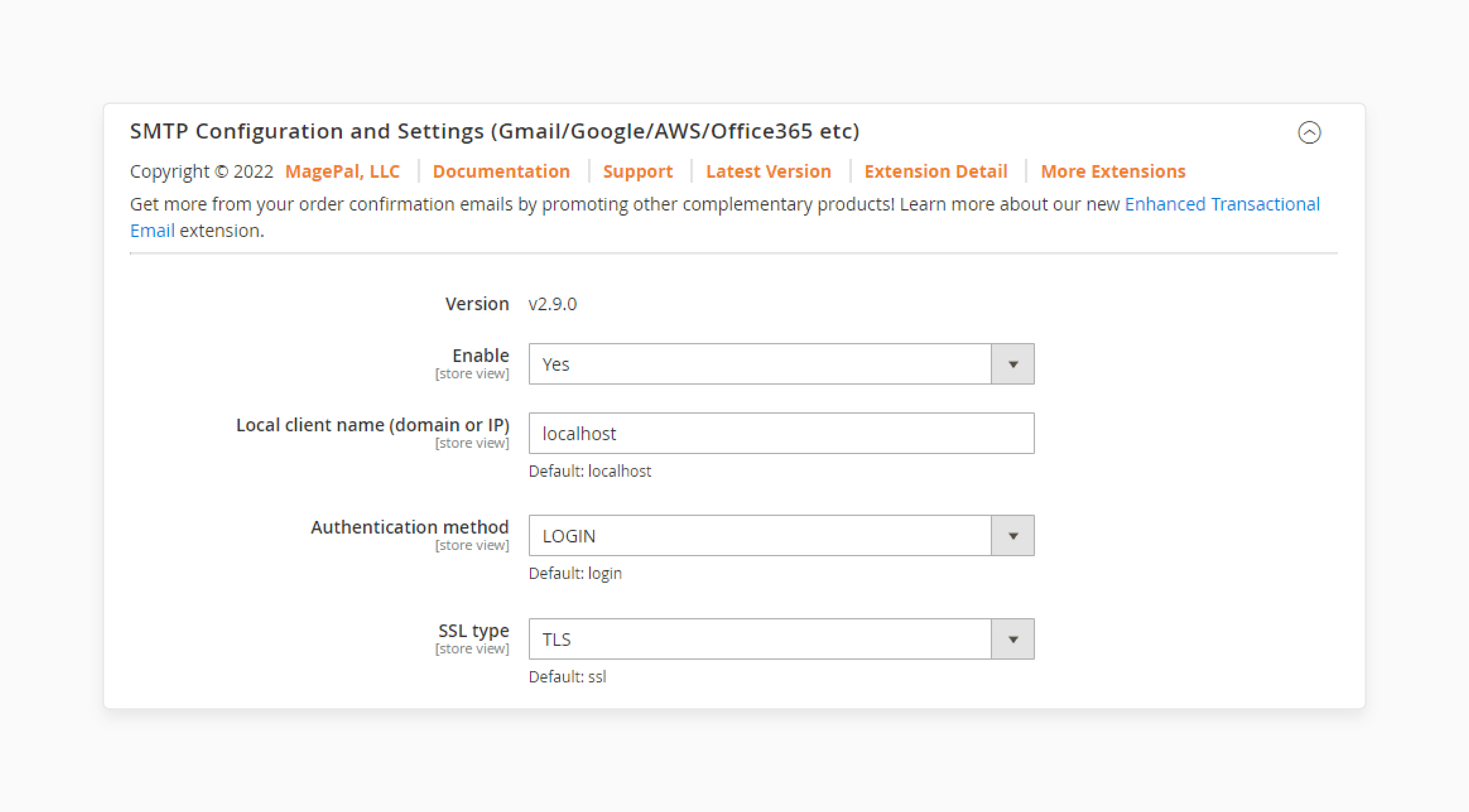
Select the encryption type for secure communication:
-
SSL for secure socket layer encryption.
-
TLS for transport layer security.
Step 5: Configure SMTP Host Settings
Provide the SMTP email for Magento details:
-
Host: Enter the mail server's hostname (e.g., smtp.example.com).
-
Port: Use the port number provided by your server administrator.
-
User Name: Enter the username for the SMTP account.
-
Password: Add the password for authentication.
Step 6: Configure Reply-To, From, and Return Path
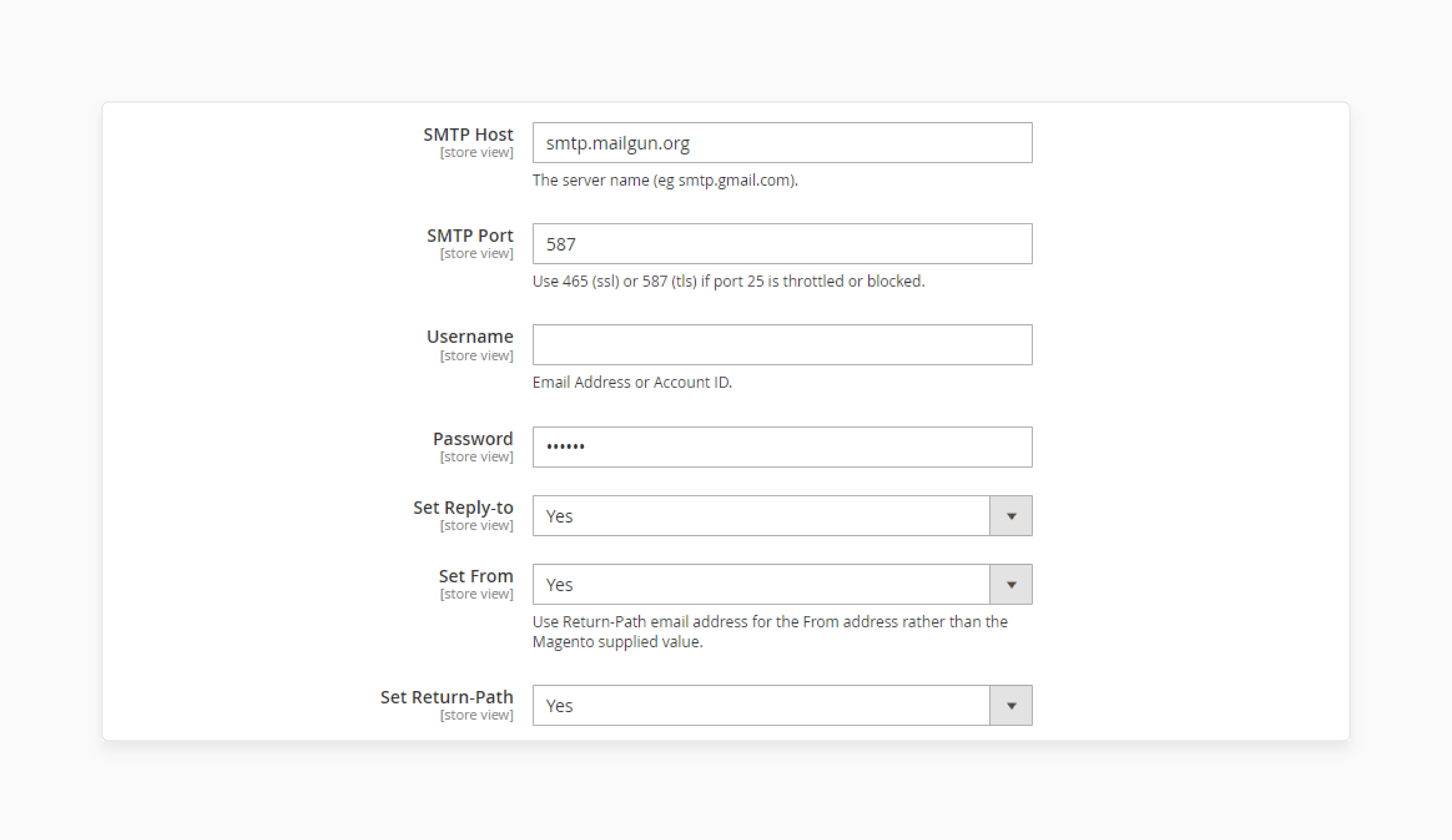
Set up a specific email for the Reply-To, From, and Return Path fields. Adjust these settings as needed.
Step 7: Save the Configuration
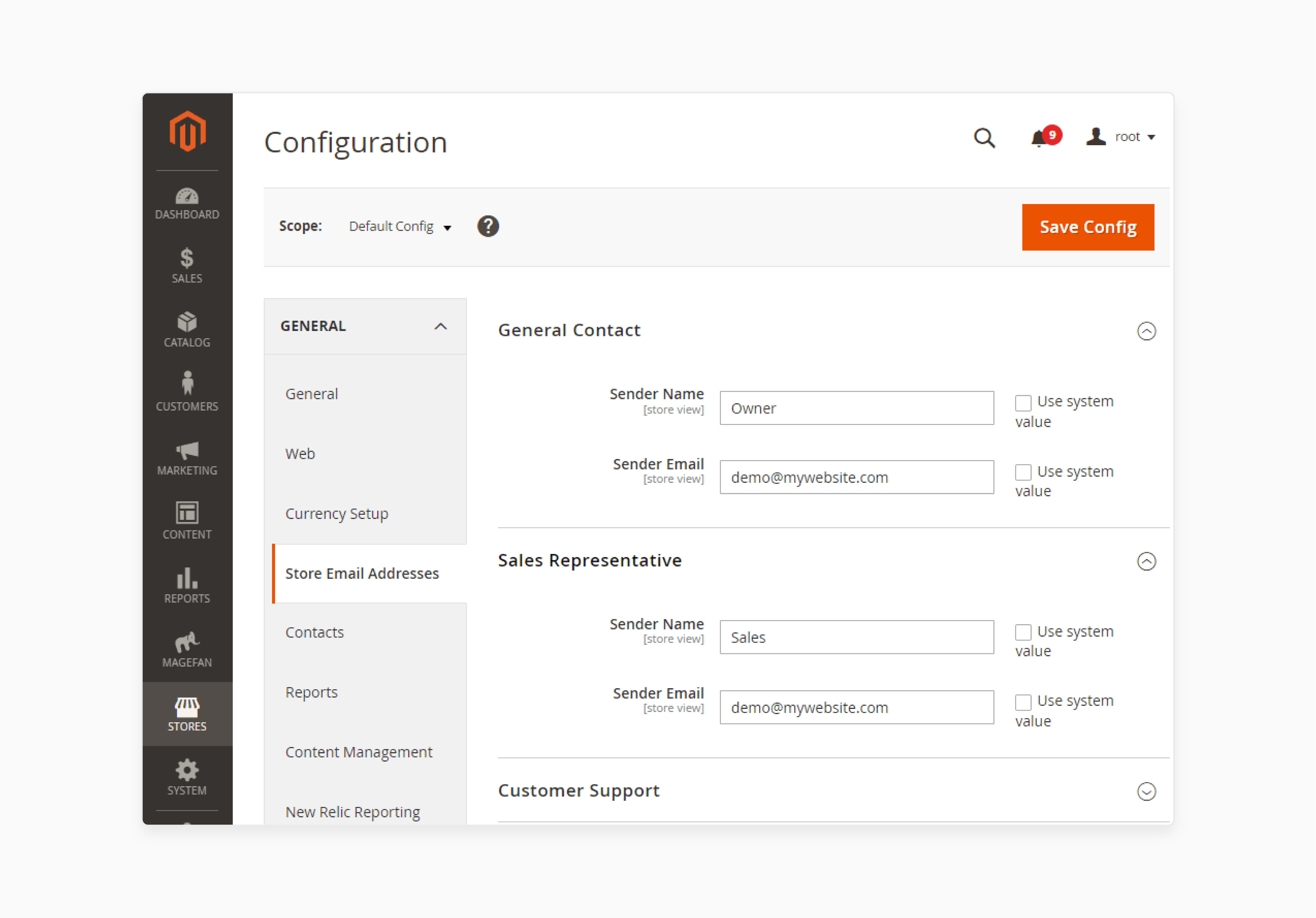
-
Click Save Config to save the changes.
-
Check your email content in Stores > Configuration > General > Store Email Addresses. Make sure all addresses are correctly configured.
Step 8: Test the Email Server Configuration
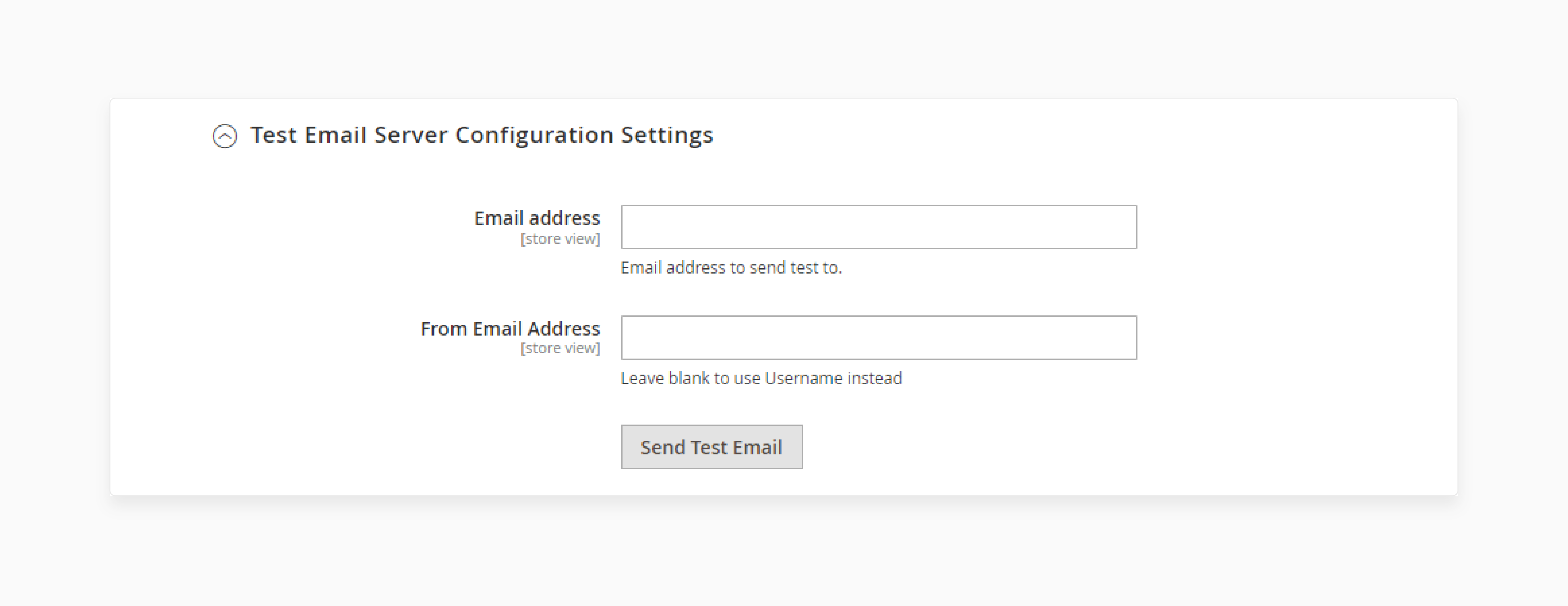
-
Set up a test by entering the following:
-
Email Address to Send Emails To: Add the recipient’s address.
-
Email Address to Send Emails From: Enter the valid mail address used for the trial email.
-
-
Click Send Test Email to confirm the setup.
Step 9: Verify the Test Mail
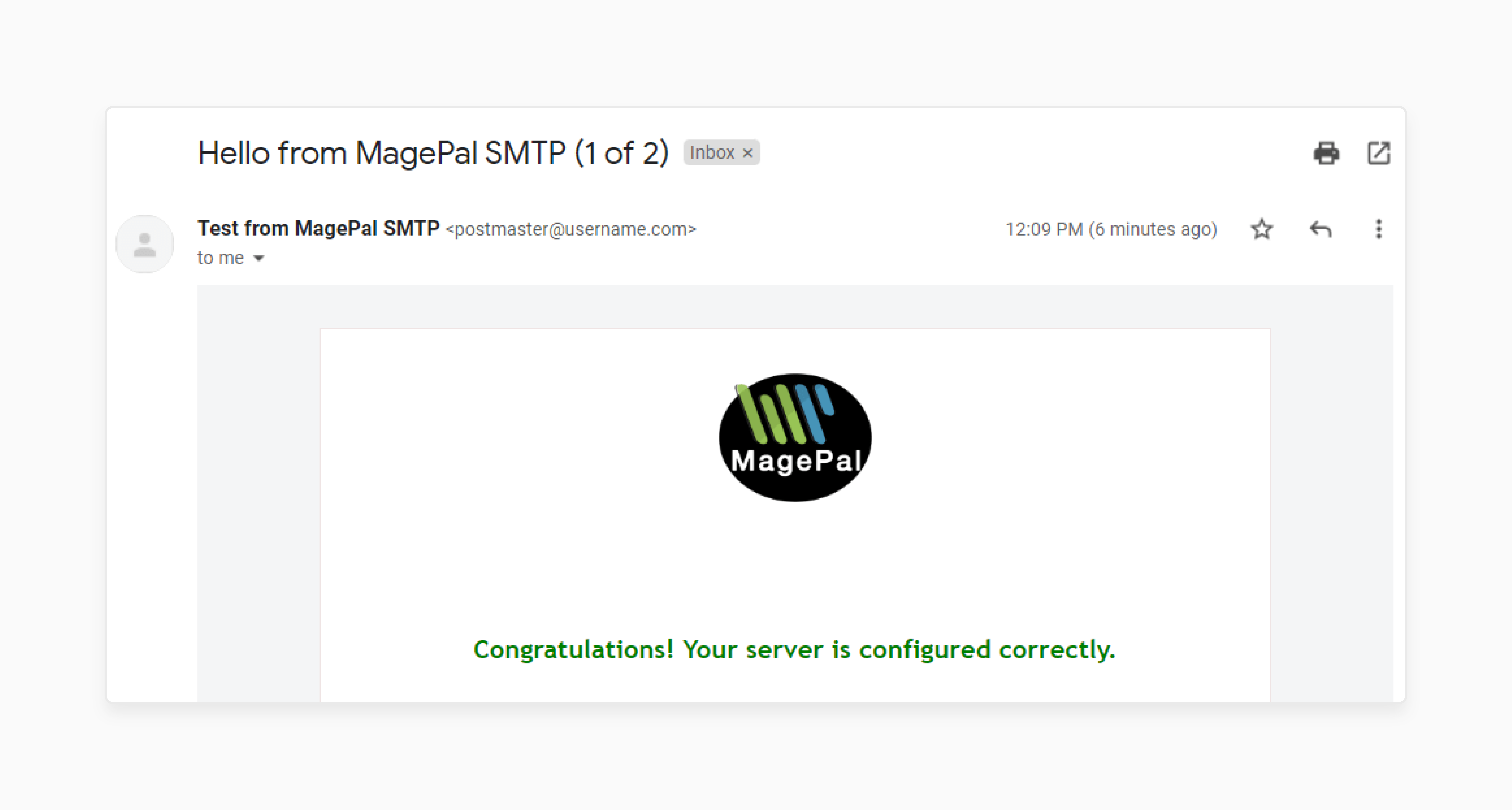
-
Check your inbox for the trial email.
-
If the email is delivered, the SMTP mail settings are correctly configured.
Top 2 SMTP Extensions for Email Settings in Magento 2
1. SMTP Email Settings for Magento 2 by Amasty
Amasty SMTP extension simplifies setting up email for secure and reliable communication. It is ideal for small and medium-sized businesses. An easy way to manage email setup within Adobe is needed.
Key Services:
-
Supports localhost or a custom SMTP node for improved mail delivery.
-
Offers basic tools to fix issues with email messages not reaching recipients.
Pricing: Starts at $129.
2. SMTP Extension for Magento 2 by Mageplaza
Mageplaza SMTP extension helps large-scale stores configure Magento 2 email setup. It is built for businesses that handle high volumes of sending and receiving emails. This needs advanced tracking options.
Key Services:
-
Provides email logs to provide the email details needed for tracking.
-
Enables custom configurations for consistent and professional e-messaging.
Pricing: Starts at $180.
13 Best Practices for Optimizing Magento Email Settings
1. Use a Reliable SMTP Host
A reliable Magento 2 SMTP node ensures emails are delivered securely and on time. For example, an online retailer sends order confirmation emails and shipping updates. It helps to avoid spam issues by using a trusted SMTP service. The setup guarantees reliable and secure mailing, informing customers without delays.
2. Authenticate Your Emails
Authentication protocols like SPF, DKIM, and DMARC ensure your emails are legitimate. For example, an electronics store facing phishing attacks can protect its customers. It is done by properly configuring SMTP in Magento 2. Authentication improves trust and ensures emails land in inboxes instead of spam folders.
3. Customize Mail Layouts
Magento allows you to create personalized mail layouts that reflect your brand. For example, a jewelry store can include its logo, elegant fonts, and customized messaging. It ensures e-messaging and makes your emails look professional.
4. Monitor Email Logs
Email logs are part of the Magento store system, helping you track outgoing emails. For example, if a customer claims they did not receive a shipping notification. They can check the logs to confirm the email was sent. Regular monitoring ensures that your email logs are accurate.
5. Test Your Email Configuration
Testing your SMTP setup in Magento 2 ensures emails are being sent correctly. For example, a bookstore launching a holiday promotion. They can use the trial email feature to verify delivery and formatting. Regular tests prevent issues with mail delivery and ensure communication runs smoothly.
6. Use a Dedicated Mail Address
Using personalized email contacts instead of a free email domain. It makes your store appear professional. For example, a pet supply store with a dedicated mail address. This improves customer trust and avoids spam filters. Always use customized email domains for a more credible brand image.
7. Set Up Store Email Contacts
Magento 2 supports assigning addresses for different functions. For example, a furniture store can set up your email setup by using sales@store.com for orders and support@store.com for queries. The organization improves communication and ensures customers get the right help quickly.
8. Leverage Third-Party SMTP Services
Third-party Magento 2 SMTP add-ons offer tools like tracking and analytics. For example, a subscription service can monitor email performance by integrating with Mailgun. These insights help businesses enhance e-messaging and improve campaign strategies.
9. Limit Batch Mailing
Sending too many emails at once can overwhelm servers. For example, a retailer sending newsletters to 100,000 customers can batch emails into 5,000 per hour. It prevents overload and ensures smooth mailing and receiving, avoiding delays.
10. Regularly Update Email Setup
Updating the email setup is necessary to match changes in Magento hosting environments. For example, a store may need to adjust its SMTP setup. It is done after switching to new Magento hosting plans. Staying updated prevents email disruptions and ensures proper communication.
11. Avoid Spam Triggers
Avoid spammy language or excessive links in your emails. For instance, instead of “ACT FAST!!!,” a fitness store can use “Save 20% on Gym Equipment Today.” Keeping content clear helps maintain effective mail communication and avoids spam filters.
12. Test Across Devices and Clients
Testing emails on multiple devices ensures consistency. For example, a travel agency can set up an email and test booking confirmations on mobile devices. It guarantees emails look professional on all platforms, improving the customer experience.
13. Backup Your Email Setup
Backing up your settings protects against disruptions. For example, a cosmetics store can save its current settings before a big sale. It helps to ensure smooth communication. If changes cause issues, they can restore the backup without delays.
9 Troubleshooting Common Issues in Magento 2 Email Settings
| Issue | Details |
|---|---|
| Emails Not Sending | Emails fail to send because of incorrect SMTP setup or server issues. Check the Magento 2 Admin Panel to ensure all details are correct. |
| Test Mail Fails | Trial emails fail due to incorrect configuration of invalid credentials. Check encryption methods like SSL or TLS for accuracy. |
| Emails in Spam | Emails go to spam if authentication is missing or the content looks spammy. Magento 2 allows you to configure SPF, DKIM, and DMARC to fix this. |
| Emails Render Wrong | Emails display incorrectly within Magento 2 if the layouts are poorly designed. Test layouts on various devices to ensure proper rendering. |
| Wrong Sender Email | The sender's email will be used incorrectly if not set up properly in-store settings. It can cause delivery failures or unprofessional emails. |
| Logs Not Updating | Logs may not update if email logging is disabled in the system for Magento stores. Enable logging to track and resolve email issues. |
| Email Delays | Delays happen when the server is overloaded or not optimized. Contact the server administrator or email hosting provider to fix performance issues. |
| Config Changes Not Applied | Setting changes may not take effect because of cached configurations within your store. Clearing the cache will apply the updates properly. |
| Emails Not Delivered | Emails may not reach recipients if they are on a blacklist-targeted mail addresses list. Verify recipient emails and ensure your domain is not blacklisted. |
FAQs
1. What is the purpose of Magento 2 SMTP settings?
SMTP setup connects your store to an SMTP host for reliable mail delivery. They ensure your emails reach customers’ inboxes and are not flagged as spam. These settings improve your store’s e-messaging.
2. How do I set up Magento 2 email for my store?
Go to the Admin Panel to configure the SMTP host settings. Add the server host, port, username, and password. Save the changes to activate mailing and ensure that notifications are received.
3. How does configuring SMTP improve email delivery for stores?
Setting up the SMTP ensures secure and reliable mail delivery. It uses authentication protocols like SPF and DKIM. This keeps your emails from being flagged as spam. A well-configured SMTP setup improves delivery success.
4. Can Magento 2 blacklist the targeted mail addresses?
Magento 2 can block targeted mail addresses. It prevents your store from dispatching emails to flagged or unwanted recipients. This helps improve efficiency and protect your store from spam risks.
5. What settings ensure consistent mail delivery?
Key settings include enabling SMTP, using secure authentication, and activating SSL/TLS encryption. These settings keep your emails safe and improve delivery reliability.
6. What should I do if emails sent from Magento fail to deliver?
Check your SMTP configuration to ensure accuracy. Verify DNS records like SPF and DKIM to authenticate emails. Trial emails to find and fix any issues with delivery.
Summary
Magento Email Settings lets sellers manage emails sent within your online store. These settings help you set up Magento 2 email configurations. By setting up an SMTP node, you can improve mail delivery. Consider the following features:
-
Store Email Contacts Configuration: Add multiple mail addresses for tasks like sales.
-
Customizable Email Layouts: Match email designs to your brand with logos and text.
-
Optimized Mail Deliverability: Set up proper settings to ensure emails avoid spam folders.
Explore Magento hosting services to enhance your Email Settings for reliable email delivery.









